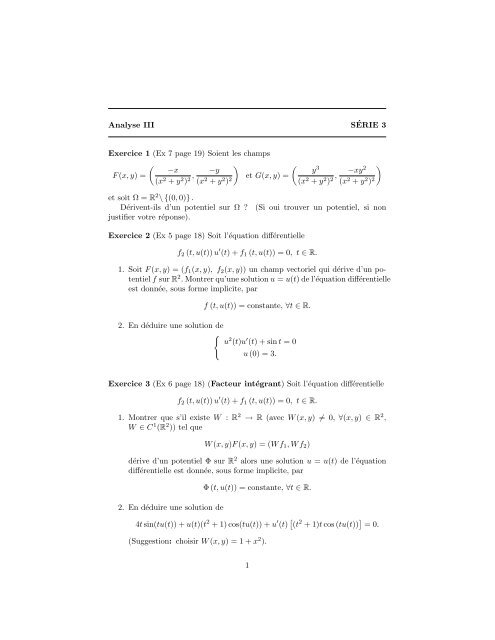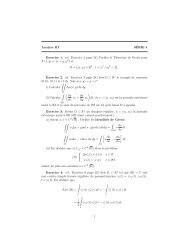Analyse III SÃRIE 3 Exercice 1 (Ex 7 page 19) Soient les champs F(x ...
Analyse III SÃRIE 3 Exercice 1 (Ex 7 page 19) Soient les champs F(x ...
Analyse III SÃRIE 3 Exercice 1 (Ex 7 page 19) Soient les champs F(x ...
Create successful ePaper yourself
Turn your PDF publications into a flip-book with our unique Google optimized e-Paper software.
<strong>Analyse</strong> <strong>III</strong> SÉRIE 3<br />
<strong><strong>Ex</strong>ercice</strong> 1 (<strong>Ex</strong> 7 <strong>page</strong> <strong>19</strong>) <strong>Soient</strong> <strong>les</strong> <strong>champs</strong><br />
(<br />
)<br />
(<br />
−x<br />
F (x, y) =<br />
(x 2 + y 2 ) 2 , −y<br />
y 3<br />
(x 2 + y 2 ) 2 et G(x, y) =<br />
(x 2 + y 2 ) 2 , −xy 2 )<br />
(x 2 + y 2 ) 2<br />
et soit Ω = R 2 \ {(0, 0)} .<br />
Dérivent-ils d’un potentiel sur Ω ?<br />
justifier votre réponse).<br />
(Si oui trouver un potentiel, si non<br />
<strong><strong>Ex</strong>ercice</strong> 2 (<strong>Ex</strong> 5 <strong>page</strong> 18) Soit l’équation différentielle<br />
f 2 (t, u(t)) u ′ (t) + f 1 (t, u(t)) = 0, t ∈ R.<br />
1. Soit F (x, y) = (f 1 (x, y), f 2 (x, y)) un champ vectoriel qui dérive d’un potentiel<br />
f sur R 2 . Montrer qu’une solution u = u(t) de l’équation différentielle<br />
est donnée, sous forme implicite, par<br />
f (t, u(t)) = constante, ∀t ∈ R.<br />
2. En déduire une solution de<br />
{<br />
u 2 (t)u ′ (t) + sin t = 0<br />
u (0) = 3.<br />
<strong><strong>Ex</strong>ercice</strong> 3 (<strong>Ex</strong> 6 <strong>page</strong> 18) (Facteur intégrant) Soit l’équation différentielle<br />
f 2 (t, u(t)) u ′ (t) + f 1 (t, u(t)) = 0, t ∈ R.<br />
1. Montrer que s’il existe W : R 2 → R (avec W (x, y) ≠ 0, ∀(x, y) ∈ R 2 ,<br />
W ∈ C 1 (R 2 )) tel que<br />
W (x, y)F (x, y) = (W f 1 , W f 2 )<br />
dérive d’un potentiel Φ sur R 2 alors une solution u = u(t) de l’équation<br />
différentielle est donnée, sous forme implicite, par<br />
2. En déduire une solution de<br />
Φ (t, u(t)) = constante, ∀t ∈ R.<br />
4t sin(tu(t)) + u(t)(t 2 + 1) cos(tu(t)) + u ′ (t) [ (t 2 + 1)t cos (tu(t)) ] = 0.<br />
(Suggestion: choisir W (x, y) = 1 + x 2 ).<br />
1
<strong><strong>Ex</strong>ercice</strong> 4: (i) Montrer qu’un ensemble convexe est connexe par arcs.<br />
(ii) Montrer qu’un intervalle est connexe.<br />
(iii) Discuter la connexité de<br />
Ω = {(x, y) ∈ R 2 : y 2 ≤ x 2 , x ≠ 0}<br />
Ω = {(x, y) ∈ R 2 : y 2 − x 2 = 1}.<br />
2





